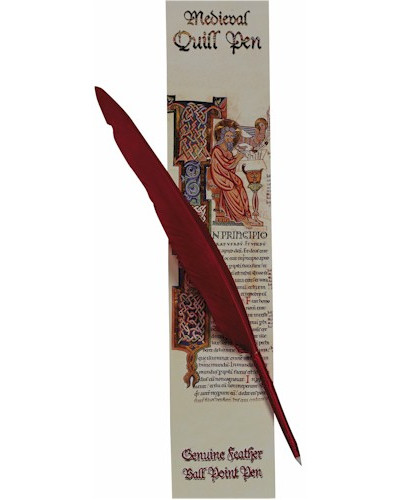Medieval Quill Pen
- Product Code: MQUILL
- Availability: In Stock
- Pack Qty: 10
Product Description: This Medieval Quill Pen is made from a real feather attached to a ribbon covered pen that has a biro nib. There are 5 different colours available, blue, purple, black, pink and red. The quill pen measures approximately 30-35 centimetres long, however lengths will vary as the feather is a natural product. The quill is supplied with a colourful information card. On the front there is an image of a section of the Worms Bible, depicting St John writing at a desk. On the back is historical information about the development of the quill pen. The quill and card are held in a clear hanging bag.
Information: The writing quill pen came into use in the seventh century. It was the main writing instrument until the introduction of metallic pens and pen nibs that took over in the 1800’s. Some of the best quill pens were made from the flight feathers of geese. The word pen comes from the Latin worn "Penna" which means feather.
After plucking the wing feathers, the barrel or the shaft needed to be carved. To cut the pens a sharp knife was needed, hence the word "penknife".
During the medieval period a scribe was someone who transcribed documents or took dictation by hand. Without scribes, little would be known of the life and times of people in the medieval world. Before the year 1100, most writing was done in monasteries and collections of manuscripts were kept there. Only the royals or the very wealthy had private libraires. Monks were given the job of copying text or of taking dictation that few outside of their walls would ever see. When the demand for books became so great, secular scribes were employed to work under the direction of the monks.
The front image depicts St. John seated in front of a desk with a book on it, and an ink-horn attached to the leg. The evangelist is writing the opening verse with a quill, and had a knife in his left hand. His symbol, the eagle, is perched on the book, and holds an inscribed roll.

